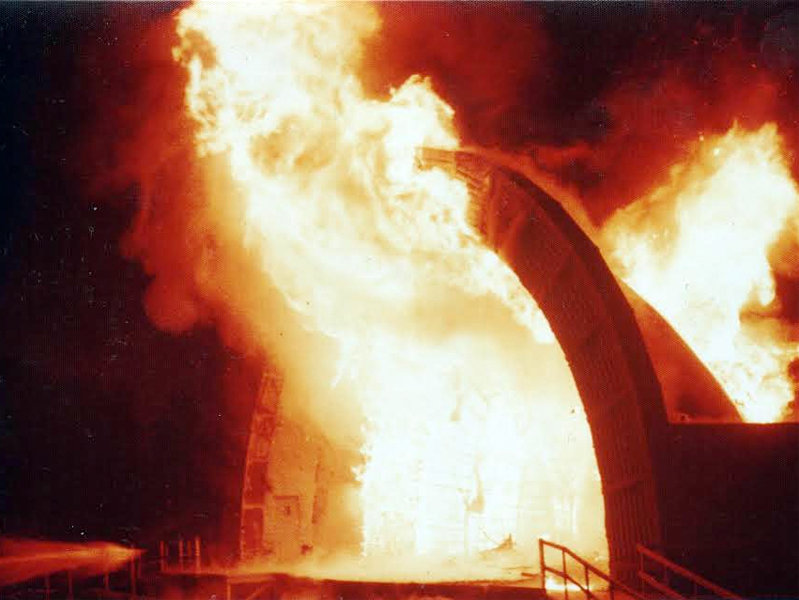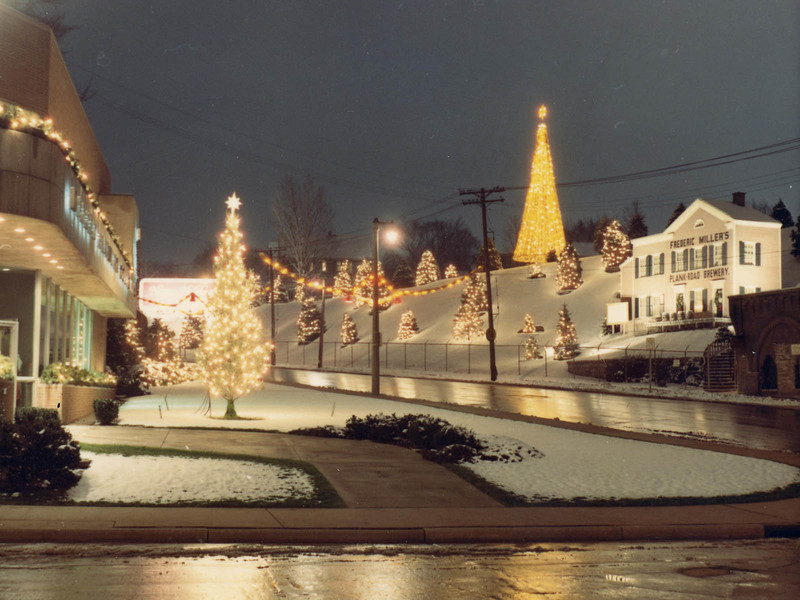This series originally ran in April 2016 for Milwaukee Day, but in honor of Milwaukee's birthday, we're re-running it to highlight the 21 people, moments and ideas that have defined Milwaukee and continue to shape the city. This is part 4 of 4. Happy birthday, MKE! Read Part 1, Part 2 and Part 3.
16. The Civil Rights Movement
The fight for civil rights started as early as 1866 when, shortly after the Emancipation Proclamation freed enslaved Africans, Ezekiel Gillespie successfully sued for the right to vote.
In the '60s, black civil rights activity increased. Father James Groppi became a figurehead in the fight for civil right for black Milwaukeeans. In 1963, he helped organized and led his congregation on marches across the 16th Street Viaduct to protest on behalf of fair housing. The 16th Street Viaduct, like the freeway system, was a symbolic divide for the city. On behalf of welfare mothers, he also organized and led a march to Madison with hispanic leaders such as Jesús Salas and Ernesto Chacón as well as Vel Phillips, Milwaukee's first black Alderperson (at the time called Madam Alderman).
Philips became the only city official to be arrested during the protests during the long hot summer of 1967, which was a year featuring 159 race riots across the United States. In 1978, Philips became the first non-white and first woman elected to the Secretary of State in Wisconsin.
After the 1968 passing of housing discrimination laws, Milwaukee enacted its own, stronger laws and eventually worked desegregate schools in the late '70s.
17. The fight for Hispanic and migrant workers rights
The '20s saw Pfister and Vogel import Hispanic workers, which started Milwaukee's Hispanic South Side community. In the '60s and early '70s, however, Latino civil rights began to develop. The United Migrant Opportunity Services was formed to organize and educate migrant farmer-workers and is currently the oldest organization of its type in the United States. Latino leaders, such as Jesús Salas, Ernesto Chacón marched to Madison with Father Groppi to keep the progress moving forward. Additionally, civil rights activist Roberto Hernández became one of the key individuals to help negotiate the first language maintenance bilingual program in Wisconsin and assisted in the enactment of Wisconsin's first Migrant Workers Act, which establishes agricultural employment standards.
In the '90s, Milwaukee's Latino population doubled, making Mitchell Street, Lincoln Village and Jackson Park neighborhoods among the densest in the city.
Today, while civil rights for all people – including blacks, Hispanics, gays and other minority groups – continue to improve, Milwaukee remains one of the most segregated cities in the country.
18. Summerfest debuts
As it turns out, Milwaukee music lovers have another far-away festival to thank for the existence of Summerfest: Oktoberfest in Munich, Germany. It was there that then Mayor Henry Maier saw the potential in a Downtown festival and, in 1968, debuted Summerfest.
Its original edition looked much different from the Summerfest we know and love now. In its first year, the festival was spread across 35 separate parts of the city. After its first few maiden voyages, however, Summerfest decided to gather all of its elements onto one place, a lakefront plot that once held an airport and Army installation that we now fittingly call the Henry Maier Festival Park.
Since then, Summerfest has only grown into the world's largest music festival (shh; nobody tell Mashable!) delivering some of the area's most memorable moments, like George Carlin's infamous 1972 performance and the 1973 Humble Pie riot, and bringing in some of music's biggest stars – like the Rolling Stones and Paul McCartney in back-to-back years.
19. Milwaukee supports sports
Milwaukee is a sports-loving town with passionate fans and a rich athletic history. There are currently five professional teams in the city, including three minor-league organizations, plus a number of college, semi-pro and amateur squads.
The basketball-playing Bucks, founded in 1968, won an NBA championship in 1971 with Hall of Famer Kareem Abdul Jabbar. They’re currently considered one of the up-and-coming young teams in the league and have a new arena coming in 2018. The baseball-playing Brewers, who replaced the Braves (1953-65) and came into existence in 1969, won the American League pennant in 1982. In 2001, Miller Park replaced County Stadium as the home field, and now, the Brewers are in the midst of a full-scale organizational rebuild.
The Admirals, founded in 1970, are Milwaukee’s American Hockey League team, while the Milwaukee Wave of the MASL, formed in 1984, has won six indoor soccer championships. As of this year, both will play in the UW-Milwaukee Panther Arena. The Torrent is the city’s newest club, an outdoor soccer franchise that begins its inaugural season in 2016. Then on the collegiate side of things, Marquette, the 1977 national champions under Al McGuire, have a proud basketball tradition and play their games at the BMO Harris Bradley Center.
There have been dozens of teams, professional and non-professional, that have come and gone over the years. Among many others, the Bears, Milwaukee’s Negro League club, competed for just one year in 1923, and the Arena Football League’s Milwaukee Mustangs had a run from 1994-2001. Back in 1957, the Braves, led by Hank Aaron and Warren Spahn, won the World Series.
20. The view from the lake: Milwaukee's architectural achievements
The overall texture and color of the city was defined by the use of Menomonee Valley clay that was found along Lake Michigan's shore. When the clay bricks, high in lime and sulfer, were fired and dried, they took on a creamy yellow color. Because of their convenience and prominence, Milwaukee earned the nickname Cream City.
By the 1850s, the bricks had achieved a reputation throughout the Midwest, partially because of their color, but also because they were well-known for their durability, strength and ability to stand up to the unpredictable and often harsh nature of the Midwest climate. Now homes and renovated industrial buildings are highly coveted for their use of the brick, since the original supply dried up.
While the Santiago Calatrava-designed addition to the Milwaukee Art Museum really launched Milwaukee into international architecture circles, the city has a long tradition of great architecture going to back to the now-landmark works of the likes of Edward Townsend Mix and Henry Koch. Later, Wisconsin-born Prairie Style works by Frank Lloyd Wright and his disciple Russell Barr Williamson followed.
From the Mitchell Park Domes to Milwaukee City Hall – briefly the world's tallest habitable building – to the "Calatrava," Milwaukee boasts a rich architectural tradition.
21. Universities help shape and define the city
Milwaukee has five primary learning institutions, including two public and three private colleges and universities. As each institution's outreach to students grow and change, their impact on the fabric of the city can be felt.
Marquette University, the oldest learning institution in the city, was named for the 17th century midwest explorer Father Jacques Marquette and was established in 1881. 28 years later, it became the first coed Catholic university in the world allowing women to join in 1909. The school's primary campus sits just west of Downtown.
The University of Wisconsin-Milwaukee had its inauspicious start in 1885 as the Wisconsin State Normal School, but it wasn't until 1955 that it was incorporated in the newly founded UW system. The belief was that Milwaukee needed a public university to become a great city. Initially located at 18th and Wells, it currently occupies in a significant portion of the upper East Side neighborhood and is continuing to expand outward, with recent extensions around the North Avenue area. It is the largest university in the Milwaukee area.
Alverno College was established in 1887 as a women's Roman Catholic college.
The Milwaukee School of Engineering was founded in 1903 and was the first school of its type to focus on applications-oriented curriculum. It is located in the heart of East Town and occupies historic buildings such as the Valentin Blatz Brewing Company Office Building and the former Federal Reserve Bank of Chicago, which features the Grohmann workers-based art museum.
Milwaukee Area Technical College was established in 1912 to help high school dropouts continue their education while they worked full time. The school is currently located in Westown and supports around 60,000 students.
The Layton School of Art, which is widely regarded as the predecessor to the Milwaukee Institute of Art and Design, was established in 1920 and opperated on Prospect Avenue until the building was razed for construction of the Park East freeway in 1970. The school moved to Port Washington Road for four more years, until it closed because it could not support itself financially. Its spiritual successor MIAD was then established in 1992 in the Third Ward's old industrial district and continues to shape the look of the rapidly developing neighborhood.







